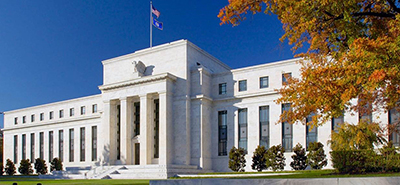
Fed Makes Tapering Official; Signals Higher Rates in the Offing

The Federal Open Market Committee—which takes pains to not rock the economic boat—announced yesterday what most analysts already anticipated: that it would begin to taper its asset purchases, while gently signaling a rise in short-term interest rates in the near future.
The FOMC statement said the Fed would begin reducing its net asset purchases by $10 billion per month for Treasury securities and $5 billion per month for agency mortgage-backed securities. And while it did not set a timetable for increases in the federal funds rate, the FOMC said it will continue to monitor economic conditions, particularly inflation, to gauge when such increases would be necessary.
“With the job market looking strong, and inflation well above target and likely to stay there for some time, the Federal Reserve moved to begin to taper their asset purchases and signaled that they are beginning to think about raising short-term rates,” said Mike Fratantoni, Chief Economist with the Mortgage Bankers Association. “The timing and amount of tapering are in line with market expectations and as previously communicated by the Fed.”
Fratantoni said the FOMC statement continues to signal it will wait to increase short-term rates until the economy has reached full employment. “Although job growth has been slower the past two months, there may well be a pickup through the remainder of the year,” he said. “Employers continue to struggle to fill millions of open positions. We expect that the economy will be at full employment by the middle of next year.”
Fratantoni also noted the pace of home-price growth and rental growth will likely be reflected in faster growth of the shelter components in several inflation measures. “This trend is one reason why we believe that higher inflation is likely to persist,” he said. “Shelter prices continue to face upward pressures because of the lack of for-sale inventory and decreasing vacancy rates for apartments.”
As the Fed’s actions were anticipated, Fratantoni said the FOMC announcement will not impact MBA’s latest forecast for mortgage rates and mortgage originations. “We expect that rates on 30-year mortgages will increase from 3.2% today to about 4% by the end of 2022,” he said.
The full FOMC statement appears below:
“The Federal Reserve is committed to using its full range of tools to support the U.S. economy in this challenging time, thereby promoting its maximum employment and price stability goals.
“With progress on vaccinations and strong policy support, indicators of economic activity and employment have continued to strengthen. The sectors most adversely affected by the pandemic have improved in recent months, but the summer’s rise in COVID-19 cases has slowed their recovery. Inflation is elevated, largely reflecting factors that are expected to be transitory. Supply and demand imbalances related to the pandemic and the reopening of the economy have contributed to sizable price increases in some sectors. Overall financial conditions remain accommodative, in part reflecting policy measures to support the economy and the flow of credit to U.S. households and businesses.
“The path of the economy continues to depend on the course of the virus. Progress on vaccinations and an easing of supply constraints are expected to support continued gains in economic activity and employment as well as a reduction in inflation. Risks to the economic outlook remain.
“The Committee seeks to achieve maximum employment and inflation at the rate of 2 percent over the longer run. With inflation having run persistently below this longer-run goal, the Committee will aim to achieve inflation moderately above 2 percent for some time so that inflation averages 2 percent over time and longer‑term inflation expectations remain well anchored at 2 percent. The Committee expects to maintain an accommodative stance of monetary policy until these outcomes are achieved. The Committee decided to keep the target range for the federal funds rate at 0 to 1/4 percent and expects it will be appropriate to maintain this target range until labor market conditions have reached levels consistent with the Committee’s assessments of maximum employment and inflation has risen to 2 percent and is on track to moderately exceed 2 percent for some time.
“In light of the substantial further progress the economy has made toward the Committee’s goals since last December, the Committee decided to begin reducing the monthly pace of its net asset purchases by $10 billion for Treasury securities and $5 billion for agency mortgage-backed securities. Beginning later this month, the Committee will increase its holdings of Treasury securities by at least $70 billion per month and of agency mortgage‑backed securities by at least $35 billion per month. Beginning in December, the Committee will increase its holdings of Treasury securities by at least $60 billion per month and of agency mortgage-backed securities by at least $30 billion per month. The Committee judges that similar reductions in the pace of net asset purchases will likely be appropriate each month, but it is prepared to adjust the pace of purchases if warranted by changes in the economic outlook. The Federal Reserve’s ongoing purchases and holdings of securities will continue to foster smooth market functioning and accommodative financial conditions, thereby supporting the flow of credit to households and businesses.
“In assessing the appropriate stance of monetary policy, the Committee will continue to monitor the implications of incoming information for the economic outlook. The Committee would be prepared to adjust the stance of monetary policy as appropriate if risks emerge that could impede the attainment of the Committee’s goals. The Committee’s assessments will take into account a wide range of information, including readings on public health, labor market conditions, inflation pressures and inflation expectations, and financial and international developments.
“Voting for the monetary policy action were Jerome H. Powell, Chair; John C. Williams, Vice Chair; Thomas I. Barkin; Raphael W. Bostic; Michelle W. Bowman; Lael Brainard; Richard H. Clarida; Mary C. Daly; Charles L. Evans; Randal K. Quarles; and Christopher J. Waller.”
